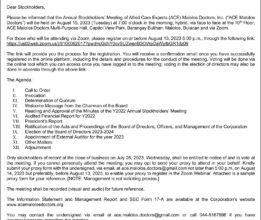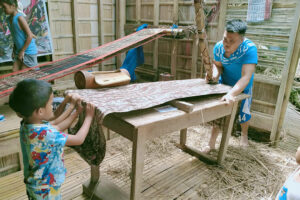Rice farmers urged to adjust seeding practices to raise yields

THE Philippine Rice Research Institute (PhilRice) issued an advisory to farmers calling for adjustments to their seeding practices in order to realize improved yields.
PhilRice said that it recommends 40 kilograms (kg) of seed per hectare for transplanted rice and 60 to 80 kg per hectare for direct-seeded rice, assuming the adoption of high-quality seed varieties.
The seeding rate refers to the amount of rice seeds planted per hectare.
“When this is followed, rice plants grow healthier because they can receive sufficient sunlight and evenly absorb nutrients from the soil… This recommendation results in good yield and lower farm expenses,” PhilRice Chief Science Research Specialist Rizal G. Corales said in a statement.
PhilRice reported that the typical seeding rate is 200 to 250 kg per hectare, because farmers want a safety margin in case their fields are attacked by pests.
Mr. Corales said that planting beyond the recommended rate makes farmers spend more while resulting in insignificant yield gains.
“There are at least 1.6 million seeds in 40 kg. A one-hectare farm needs 750,000 seedlings, at 3 seedlings per hill. If high-quality seed has a germination rate of at least 85%, then 40 kg can produce 1.3 million seedlings. There could be around 600,000 extra seedlings that farmers can use for replanting in case pests cause damage,” he added.
PhilRice said the Rice Competitiveness Enhancement Fund (RCEF) Seed Program is implementing the recommended practice through its services.
“High-quality seed has a high germination rate. Farmers are assured that 40 kg is enough because most seeds will germinate. Farmers used to struggle in following the recommendation because they do not have access to high-quality seed,” Mr. Corales said.
“They source planting materials from their own harvests or from fellow farmers, so seeds did not undergo quality control. Now, access to high-quality is easier with the program,” he added.
The RCEF Seed Program also conducts technology demonstrations to show the effect of using the recommended seeding rate, alongside other modern technologies and practices.
Recommended farm machines include drum seeders, seed spreaders, precision spreaders, and drone seeder for direct seeding.
In a recent study, PhilRice reported that the 42 target provinces of the seed program showed that farmers reduced the amount of seeds they used to 86 kg during the dry season last year.
“We hope to further reduce the seeding rate with the use of farm machinery being used and showcased in various technology demonstration sites established nationwide,” Mr. Corales said.
“If farmers in RCEF’s target areas follow the recommendation, it would mean more farmers can be reached and more rice areas can be planted through the program. At most, our overall production can increase and there will be more sources of our country’s staple food,” PhilRice RCEF Program Management Office Head Flordeliza H. Bordey added.
The RCEF-Seed Program is a component of the Rice Tariffication Law, which allots P10-billion funds every year for rice farmers from rice tariff earnings. — Luisa Maria Jacinta C. Jocson




